Images of dry tropical habitat: Mexico II
Click on the image
or text link for a gallery of thumbnail images of plants, animals, and landscapes
of some of the dry parts of the tropics:
Plants
1. 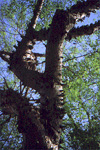 2.
2.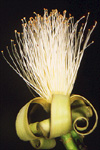 3.
3.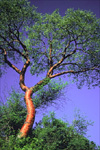 4.
4.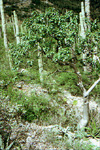 5.
5.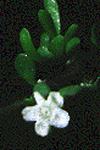 6.
6.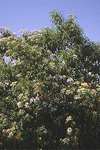 7.
7. 8.
8. 9.
9.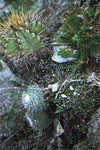 10.
10.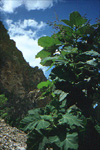 11.
11.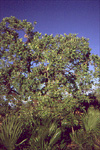 12.
12.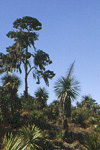 13.
13.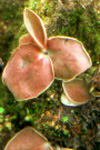
- 1. The trunk of Ceiba parvifolia
(Bombacaceae) is covered with long, woody prickles.
- 2. The flowers of Pseudobombax
(also Bombacaceae) appear when during the leafless dry season.
- 3. Bursera longipes
is one of the many species of Bursera that populate
Mexican dry forest. The coppery bark of this species is particularly
striking. This one is from central Guerrero.
- 4. Another odd inhabitant
of Mexican dry forests is Ipomoea arborescens, a member of the
Morning Glory Family (Convolvulaceae), and in the same genus as the sweet
potato (Ipomoea batatas)! This individual was photographed in southern
Puebla.
- 5. A flowering twig
of Lycium, in the Tomato Family (Solanaceae).
- 6. and 7. The genus
Cordia in the Boraginaceae has a center of diversity
in Mexican dry forests. 5. shows a tree of Cordia eleagnoides and
6. is Cordia curassavica, both from Guerrero.
- 8. Cacti are often
associated with deserts, but cactus diversity is actually highest within
the tropics. Cactus densities are also often very high, as can be seen
in this dense thicket of at least 4 species of cactus in southern Puebla.
The tree in the upper right corner is Cercidium praecox. The
tufts in its branches are a species of Tillandsia .
- 9. The cacti
Astrophytum ornatum (upper cactus) and Mammillaria
hahniana (lower cactus) are commonly cultivated as ornamentals. In
the wild, they occur in a rich community with many other plants. In this
photo taken on a steep limestone cliff, the cacti are growing with ferns,
liverworts, and Commelinaceae. The green fronds on the middle right are
the a club moss Selaginella.
- 10. The broad,
dark green leaves of Wigandia urens (Hydrophyllaceae)
are covered with tiny, stinging hairs. This one was photographed in
Hidalgo.
- 11. At the
upper elevational extent of tropical dry forests in Mexico, there is
often a transition to oak forest. At these elevations, it is common to
find associations like this one in southwestern Puebla of oaks and palm
trees growing together.
- 12. Still
higher, in eastern Puebla, communities of Nolina,
Dasylirion (Agavaceae), and piñon pine. The pine is draped
with tresses of the epiphytic bromeliad Tillandsia usneoides .
- 13. The
carnivorous Butterwort genus Pinguicula (Lentibulariaceae) has
a center of diversity in Mexico. While usually thought of as growing
in wet places, there are numerous species that are found in seasonally
dry habitats.
-
Landscapes
1.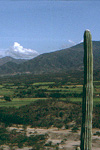 2.
2.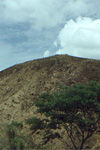 3.
3.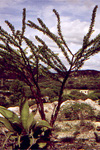 4.
4.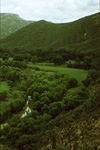 5
5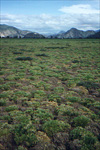 6.
6.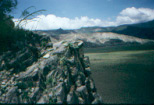
- 1.
Tropical dry forests usually have more fertile soils than tropical rain
forests. As a consequence, tropical dry forests are in a much more advanced
state of destruction than rain forests. This view in the southern Tehuacán
- Cuicatlán Valley of northern Oaxaca is typical: the entire valley
floor that can be seen here has been destroyed and replaced by sugar
cane and other crops. Intact and disturbed forest remains on slopes
too steep to cultivate.
-
2. The rich forest on this hillside in Michoacán has been recently
cleared and burned to produce pasture.
-
3. The Iguana's Tail Tree (Fouquieria ochoterrenae) is only found
in a few places in southern Puebla and northern Oaxaca. The heaps of
soil behind this lone individual are all that remains of this stand that
was recently bulldozed to make way for a factory.
-
4. The original vegetation in the bed of the Venados River in Hidalgo
has largely been destroyed for cultivation, while the slopes often have
relatively intact dry forest.
-
5. - 6. Natural lakes are rare in the Mexican dry tropics, making Lake
Metztitlán in Hidalgo a precious resource and a place of inestimable
scientific and social interest. Photo 7. shows the wide shore of the
lake during a dry period, while photo 6. is a view of the bed from the
northwestern cliffs. A small group of local people subsist on fishing
endemic fish from the lake for local sale.
home - people -
research - images of the dry
tropics - exploration
- acknowledgements
Instituto de Biología, Universidad Nacional Autónoma
de México
Circuito Exterior s/n, Ciudad Universitaria
Copilco, Coyoacán A. P. 70-367
C. P. 04510, México, D. F.
MÉXICO
(52) 55 5622-9127 fon (52) 55 5555-1760 fax
molson@ibiologia.unam.mx
all material © 2002 Mark E Olson
 2.
2. 3.
3. 4.
4. 5.
5. 6.
6. 7.
7. 8.
8. 9.
9. 10.
10. 11.
11. 12.
12. 13.
13.
 2.
2. 3.
3. 4.
4. 5.
5. 6.
6. 7.
7. 8.
8. 9.
9. 10.
10. 11.
11. 12.
12. 13.
13.